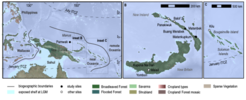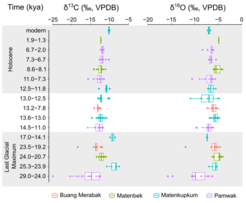Biochemical Evidence Reveals Subtle Environmental Changes on the Islands of Near Oceania During the Last Glacial Maximum
A new study, led by researchers at the Max Planck Institute of Geoanthropology, the University of Otago, and the Australian National University uses chemical information from excavated animal teeth to study the impact of climate change on human-occupied island environments in the Bismarck Archipelago.
The Last Glacial Maximum, and the following transition from the Pleistocene (125-11.7 thousand years ago) to the Holocene (11.7 thousand years ago to present), represent the most significant period of climate change, prior to the industrial revolution, to have impacted our species after it had already occupied all of the planet’s continents (except Antarctica). Although dramatic changes in temperature and aridity are known for different parts of the northern hemisphere at this time, changes in the tropics often remain less known.

This can be a problem for regions such as the islands of Near Oceania, including the Bismarck Archipelago, which provides an important case study for exploring how our species adapted to fauna-poor tropical island environments and marine navigation from 44,000 years ago. Here, any climate changes could have significant impacts on plant and animal species and the environments available to humans, but are poorly-understood.
In this new study, the researchers used biochemical information (stable isotope analysis) about diet and environment from the teeth of animals uncovered at a series of archaeological sites in the Bismarck Archipelago. These animals, including bandicoots and cuscus, date to between 29,000 years ago and 1,000 years ago. Alongside clear evidence for human hunting of these animals, this means they provide a unique record of environmental change, of direct relevance to human societies, across the critical Pleistocene-Holocene transition.

The results show some slight environmental changes, with drier conditions leading to more open forest cover during the Last Glacial Maximum followed by tropical forest expansion. These changes may have influenced human adaptations and social behaviors across this time period though, overall, they are more dampened than those seen in other parts of the world.
The authors argue that this research highlights the need for locally-specific studies of climate and environmental change during the late glacial, particularly across the tropics, where such human-environment interactions have often been deemed inherently less significant compared to temperate and arid zones.

